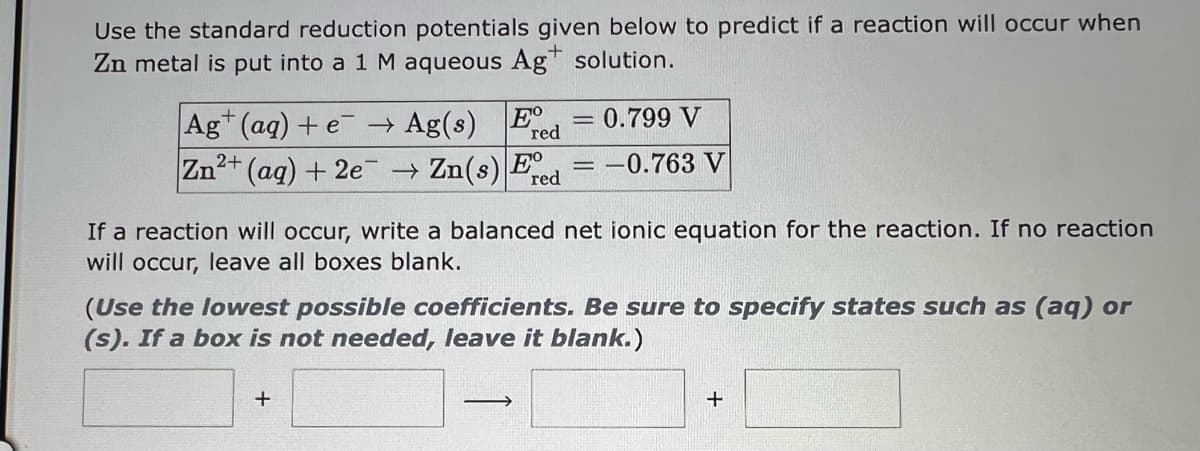Use the standard reduction potentials given below to predict if a reaction will occur when Zn metal is put into a 1 M aqueous Ag+ solution. Ag+ (aq) + e → Ag(s) Eº red → Zn(s) E red 2+ Zn²+ (aq) + 2e7 0.799 V -0.763 V If a reaction will occur, write a balanced net ionic equation for the reaction. If no reaction will occur, leave all boxes blank. + (Use the lowest possible coefficients. Be sure to specify states such as (aq) or (s). If a box is not needed, leave it blank.) +
Use the standard reduction potentials given below to predict if a reaction will occur when Zn metal is put into a 1 M aqueous Ag+ solution. Ag+ (aq) + e → Ag(s) Eº red → Zn(s) E red 2+ Zn²+ (aq) + 2e7 0.799 V -0.763 V If a reaction will occur, write a balanced net ionic equation for the reaction. If no reaction will occur, leave all boxes blank. + (Use the lowest possible coefficients. Be sure to specify states such as (aq) or (s). If a box is not needed, leave it blank.) +
Chemistry & Chemical Reactivity
10th Edition
ISBN:9781337399074
Author:John C. Kotz, Paul M. Treichel, John Townsend, David Treichel
Publisher:John C. Kotz, Paul M. Treichel, John Townsend, David Treichel
Chapter19: Principles Of Chemical Reactivity: Electron Transfer Reactions
Section: Chapter Questions
Problem 94GQ: A voltaic cell is constructed in which one half-cell consists of a silver wire in an aqueous...
Related questions
Question

Transcribed Image Text:Use the standard reduction potentials given below to predict if a reaction will occur when
Zn metal is put into a 1 M aqueous Ag+ solution.
Ag+ (aq) + e → Ag(s) E⁰
red
→ Zn(s) E red
2+
Zn²+ (aq) + 2e7
0.799 V
-0.763 V
If a reaction will occur, write a balanced net ionic equation for the reaction. If no reaction
will occur, leave all boxes blank.
+
(Use the lowest possible coefficients. Be sure to specify states such as (aq) or
(s). If a box is not needed, leave it blank.)
+
Expert Solution
This question has been solved!
Explore an expertly crafted, step-by-step solution for a thorough understanding of key concepts.
This is a popular solution!
Trending now
This is a popular solution!
Step by step
Solved in 3 steps with 3 images

Knowledge Booster
Learn more about
Need a deep-dive on the concept behind this application? Look no further. Learn more about this topic, chemistry and related others by exploring similar questions and additional content below.Recommended textbooks for you

Chemistry & Chemical Reactivity
Chemistry
ISBN:
9781337399074
Author:
John C. Kotz, Paul M. Treichel, John Townsend, David Treichel
Publisher:
Cengage Learning

Chemistry & Chemical Reactivity
Chemistry
ISBN:
9781133949640
Author:
John C. Kotz, Paul M. Treichel, John Townsend, David Treichel
Publisher:
Cengage Learning

Chemistry: The Molecular Science
Chemistry
ISBN:
9781285199047
Author:
John W. Moore, Conrad L. Stanitski
Publisher:
Cengage Learning

Chemistry & Chemical Reactivity
Chemistry
ISBN:
9781337399074
Author:
John C. Kotz, Paul M. Treichel, John Townsend, David Treichel
Publisher:
Cengage Learning

Chemistry & Chemical Reactivity
Chemistry
ISBN:
9781133949640
Author:
John C. Kotz, Paul M. Treichel, John Townsend, David Treichel
Publisher:
Cengage Learning

Chemistry: The Molecular Science
Chemistry
ISBN:
9781285199047
Author:
John W. Moore, Conrad L. Stanitski
Publisher:
Cengage Learning

Principles of Modern Chemistry
Chemistry
ISBN:
9781305079113
Author:
David W. Oxtoby, H. Pat Gillis, Laurie J. Butler
Publisher:
Cengage Learning

Chemistry
Chemistry
ISBN:
9781305957404
Author:
Steven S. Zumdahl, Susan A. Zumdahl, Donald J. DeCoste
Publisher:
Cengage Learning

Chemistry: Principles and Practice
Chemistry
ISBN:
9780534420123
Author:
Daniel L. Reger, Scott R. Goode, David W. Ball, Edward Mercer
Publisher:
Cengage Learning